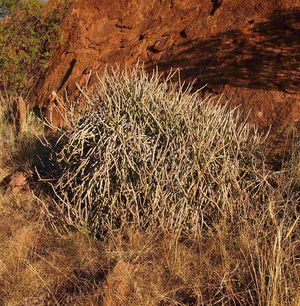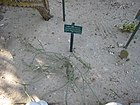Note: This is a project under development. The articles on this wiki are just being initiated and broadly incomplete. You can Help creating new pages.
Sarcostemma viminale - Caustic Vine
Cynanchum viminale is a leafless succulent plant in the milkweed family. The species is native to West Africa, the Indian Ocean and Western Pacific region.
Contents
[hide]- 1 Uses
- 2 Parts Used
- 3 Chemical Composition
- 4 Common names
- 5 Properties
- 6 Habit
- 7 Identification
- 8 List of Ayurvedic medicine in which the herb is used
- 9 Where to get the saplings
- 10 Mode of Propagation
- 11 How to plant/cultivate
- 12 Commonly seen growing in areas
- 13 Photo Gallery
- 14 References
- 15 External Links
Uses
Eye treatments, Cuts, Snakebites, Curing liver disorders, Skin eruptions, Blotches, Pimples, Diarrhea, Sore throats
Parts Used
Chemical Composition
The major fatty acids isolated and identified were1-Hexadecene (C16H32), Hexadecanoic acid (C16H32O2), Octadecanoic acid(C18H36O2), 9-Octadecenoic acid (C18H34O2), 1- Docosene (C22H44)[1]
Common names
| Language | Common name |
|---|---|
| Kannada | |
| Hindi | Khir-khimp |
| Malayalam | |
| Tamil | |
| Telugu | |
| Marathi | NA |
| Gujarathi | NA |
| Punjabi | NA |
| Kashmiri | NA |
| Sanskrit | |
| English | Caustic Vine, Milk rope |
Properties
Reference: Dravya - Substance, Rasa - Taste, Guna - Qualities, Veerya - Potency, Vipaka - Post-digesion effect, Karma - Pharmacological activity, Prabhava - Therepeutics.
Dravya
Rasa
Tikta (Bitter), Kashaya (Astringent)
Guna
Laghu (Light), Ruksha (Dry), Tikshna (Sharp)
Veerya
Ushna (Hot)
Vipaka
Katu (Pungent)
Karma
Kapha, Vata
Prabhava
Habit
Identification
Leaf
| Kind | Shape | Feature |
|---|---|---|
| Simple | Leaves reduced to small, triangular scales about 1-1.5 mm long. Photosynthetic material present in the green succulent branches which produce copious amounts of milky exudate when cut or broken. |
Flower
| Type | Size | Color and composition | Stamen | More information |
|---|---|---|---|---|
| Unisexual | 7-8 mm long | Yellow | 5-20 | Inflorescence a short raceme or fascicle. Flowering season is March-November |
Fruit
| Type | Size | Mass | Appearance | Seeds | More information |
|---|---|---|---|---|---|
| General | 7-9 x 0.4 cm | Follicles about 7-9 x 0.4 cm. Seeds about 5-6 x 1.5-2 mm, plumes about 15-17 mm long | 5-6 | Fruiting season is March-November |
Other features
List of Ayurvedic medicine in which the herb is used
Where to get the saplings
Mode of Propagation
How to plant/cultivate
Cynanchum viminale is an easy species to grow that is suited for any well drained soil in full sun. But young plant are happy growing indoors, where they can easily reach the ceiling[3]
Commonly seen growing in areas
Hotter and drier parts of Africa, Coastal and inland region.
Photo Gallery
References
External Links
- Ayurvedic Herbs known to be helpful to treat Eye treatments
- Ayurvedic Herbs known to be helpful to treat Cuts
- Ayurvedic Herbs known to be helpful to treat Snakebites
- Ayurvedic Herbs known to be helpful to treat Curing liver disorders
- Ayurvedic Herbs known to be helpful to treat Skin eruptions
- Ayurvedic Herbs known to be helpful to treat Blotches
- Ayurvedic Herbs known to be helpful to treat Pimples
- Ayurvedic Herbs known to be helpful to treat Diarrhea
- Ayurvedic Herbs known to be helpful to treat Sore throats
- Herbs with Dried folaige used in medicine
- Herbs with Whole herb used in medicine
- Herbs with common name in Hindi
- Herbs with common name in English
- Habit - Tree
- Index of Plants which can be propagated by Seeds
- Index of Plants which can be propagated by Cuttings
- Herbs that are commonly seen in the region of Hotter and drier parts of Africa
- Herbs that are commonly seen in the region of Coastal and inland region
- Herbs
- Ayurvedic herbs that don't have flower, fruit and leaf photos
- Ayurvedic herbs that don't have seed photos
- Apocynaceae





